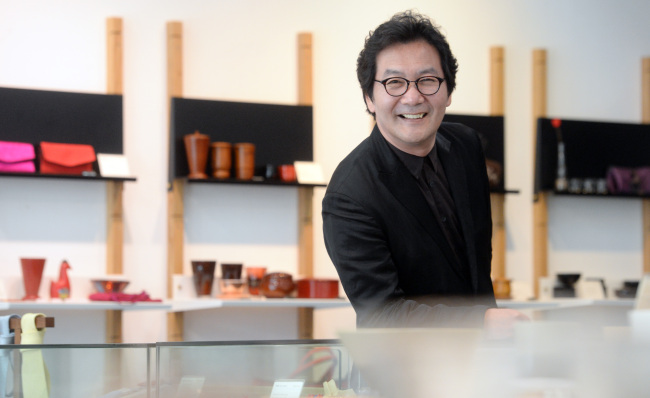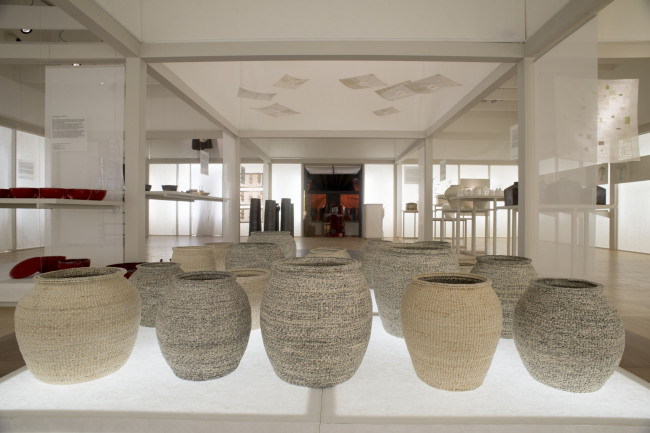Dreaming of a Korean craft renaissance
Korea Craft and Design Foundation chief Choi Jeong-cheol pushes to popularize traditional crafts
By Korea HeraldPublished : April 17, 2015 - 19:09
Throngs of foreign tourists stroll the streets of Insa-dong. The popular neighborhood in upper Seoul is famous for antiques, traditional crafts and art galleries and is considered a must-see location for those looking for a taste of “real Korea.” But most souvenirs sold in the area are anything but authentic.

Fans, wooden masks, traditional accessories and folk dolls ― whichever souvenir tourists take home, there is a chance it was not made in Korea.
“Insa-dong is flooded with items from Southeast Asia,” said Choi Jeong-cheol, chief of the state-run Korea Craft and Design Foundation, in his office, just a few blocks from Insa-dong.
The origins of the low-priced keepsakes may not be a core issue, though. What concerns Choi the most is the underlying state of Korean craft ― even those with a more generous budget find it difficult to buy souvenirs that are classy, authentic and representative of Korean culture.
As the chief promoter of traditional craft and design, Choi knows this all too well. Various government agencies, including the Presidential Office, have asked him to make recommendations for the country’s official gifts for visiting heads of states and other VIP guests.
“Japan has those beckoning cats. Russia has the matryoshka dolls. What do we have? What would you give as a gift to a foreign friend?” he said.
The dearth of traditional souvenirs, Choi believes, reflects the lethargic state of the Korean craft scene.
“Korean crafts ― the tradition, artistry and craftsmanship ― are not lost. They are being carried on by a few remaining artisans. What has been lost is their contact with today’s masses,” he said.
“Now, people don’t think of a mother-of-pearl inlaid jewelry box as an item they would have at home.”
Those jewelry boxes are now more appropriate at a museum, than a home.
While the Cultural Heritage Administration works to preserve time-honored skills as part of its efforts to protect the country’s intangible cultural assets, his agency ― the KCDF ― is tasked with restoring the link between artisans and today’s consumers, whose artistic taste has become somewhat Westernized, he continued.
“Today, many Koreans look for modern, minimalistic designs. So we, at KCDF, try to help artisans create works with modern aesthetic sensibilities. We also help them market their products and reach consumers both here and abroad.”

As one can imagine, marrying time-honored craftsmanship to modern design is not easy.
“Artisans tend to be obstinate. Often, there are conflicts of opinions as to what makes the core elements of a tradition that should never be compromised,” the director explained.
But as hard as the process is, the rewards can be great.
Some of the works, created through a fusion of a modern and traditional approach, became a hit in overseas exhibitions, and several pieces were sold to overseas galleries and museums, Choi said.
“It seems that foreigners better appreciate our traditional crafts, when their simplistic, natural and restrained beauty is supplemented by modern twists, compared to Koreans,” he said.
To popularize local crafts here and create a market for them, the KCDF operates galleries, including one in Insa-dong. All proceeds from sales go to artisans and designers.
“We plan to expand distribution and sales channels. We also plan to expand the quality certification system, which we introduced last year in the field of ceramics, to metal crafts this year,” he said.
Prior to assuming the top position at the KCDF in October 2013, Choi was a designer, specializing in space design, and leading several major projects for the government and big companies.
He said he draws on his extensive work experience in the industry when tending to the other core part of his job at the KCDF ― promoting public designs.
The KCDF was established in 2010 by the merger of two existing entities ― one promoting tradition crafts and the other a design foundation.
The organization runs the old Seoul Station building, renamed Culture Station Seoul 284, which hosts various exhibitions and cultural events. Currently, the exhibition “Beyond the Borders” is on display, featuring 100 pieces, including sculptures, paintings and artworks from 29 local artists.
In October, it will co-host a major international design conference with the southern city of Gwangju, where nearly 3,000 design professionals from Korea and overseas are expected to gather.
“Our organization is being called upon to step up since the launch of the current administration, which puts great emphasis on culture,” Choi said.
From hanbok, the Korean costume, to hanji, traditional handmade paper, the KCDF is responsible for promoting everything that starts with “han,” which means Korean.
“Work is piling up, but we’re short-staffed. Our annual budget has been growing (the KCDF’s budget for this year is around 30 billion won ($28 million)), but we would still need a further increase going forward,” he said.
“With growing public interest and the government’s backing, now is a golden time to advance Korea’s craft and design powers.”
By Lee Sun-young (milaya@heraldcorp.com)
-
Articles by Korea Herald











![[Today’s K-pop] BTS pop-up event to come to Seoul](http://res.heraldm.com/phpwas/restmb_idxmake.php?idx=644&simg=/content/image/2024/04/17/20240417050734_0.jpg&u=)





![[KH Explains] Hyundai's full hybrid edge to pay off amid slow transition to pure EVs](http://res.heraldm.com/phpwas/restmb_idxmake.php?idx=652&simg=/content/image/2024/04/18/20240418050645_0.jpg&u=20240419100350)

